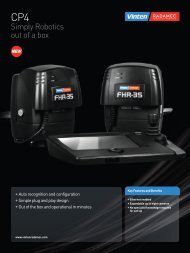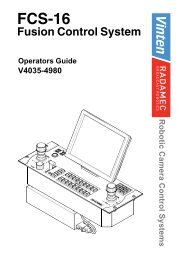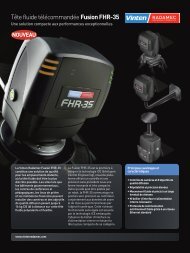SP-2000/X-Y AutoCam⢠Pedestal - Vinten Radamec
SP-2000/X-Y AutoCam⢠Pedestal - Vinten Radamec
SP-2000/X-Y AutoCam⢠Pedestal - Vinten Radamec
- No tags were found...
You also want an ePaper? Increase the reach of your titles
YUMPU automatically turns print PDFs into web optimized ePapers that Google loves.
<strong>SP</strong>-<strong>2000</strong>/X-YMaintenance And RepairThe Targeting SystemThe targeting system in the pedestal consists primarily of the Dolly Board andthe three sensors. If the controller is operating normally, the cables are ok andthe target itself is clean, a failure to target is likely to be caused by a problem inthe sensors (cleaning or calibration) or the Dolly Board.Lowering The SensorsIn normal operation, the Dolly Board supplies +24V to the three chassismounted solenoids. Targeting is initiated by an active low signal from the DollyBoard to energize the solenoids and drop the sensors.Each solenoid operates an arm to lower the respective sensor assembly onto thetarget. The arm is counterbalanced so that the arm lower smoothly when thesolenoid is energized and will retract under the force of gravity.The Sensor AssemblyEach sensor assembly contains three optosensors that generate red and infraredlight and detect the light reflected off the target. The three sensors provide forredundancy in case of dirt or marks on the target. Each sensor assembly is connectedby a cable to the Dolly Board that provides sensor power and detects thesensor output. The sensor assemblies are somewhat difficult to access, so theiroperation is best verified from measurements made on the Dolly Board.If the sensors are kept clean (as described earlier in this chapter) and the targetsthemselves are also kept clean and free from damage such as delamination, thereshould be no need for electrical readjustments of the sensor voltage offsets.The Dolly BoardThe Dolly Board performs several functions including local control and targeting.When the pedestal is controlled by the MCB controller, the Dolly Boardinterprets the local control joystick output and generates the serial data signalsto control the pedestal. The Dolly Board also controls the targeting operation.U15 and Q22 activate the solenoids which lower the three sensors to read thetarget. U19, U20, U21 and U16 interpret the signals from the three optosensorson each sensor assembly. The three signals from each sensor block are voted toreduce errors caused by floor dirt. The threshold values on the sensors aretracked electronically to allow for the slow accumulation of film on the optosensorwindows.The Dolly Board is controlled by microprocessor U9, with ROM (U3), RAM(U2), and peripheral devices. Basic operation of the microprocessor may beconfirmed by looking for signal activity at pins 26, 27, and 28. The RS-422 datapath section of U15, U27, U28 and associated circuitry manages the rerouting ofdata when control is transferred from remote to local. The analog sectionincluding U24, U25 and U17 buffers and measures signals from the joystick onthe MCB controller.4-34 User Manual
















